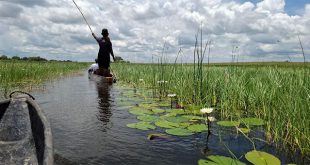
By Flavia Nassaka
The Zika strain spreading in America is of Asian origin
Ziika forest reserve along the Kampala-Entebbe Highway has until recently been relatively unknown. But Gerald Mukisa, a guide at the forest says that is quickly changing since it was revealed that the Zika virus behind the outbreak in South America was first identified here.
Speaking in Luganda, the local dialect, Mukisa says I was the sixth person to visit that day by around midday on Jan.29.He says instead of the secondary school students, he is receiving journalists, tourists, researchers, and scientists.
“For the seven years I’ve been here I had never registered such big numbers. Since the outbreak of that fever, foreign researchers have been frequenting here,” he says as he flips through his visitors’ registration book.

We are standing in front of his house, a round metallic prefab uniport, surrounded by dense vegetation, noisy birds, and stinging mosquitoes.According to him, the mosquitoes do not transmit any disease.
But Mukisa does not know much about the forest which sits on 25 acres in Kisubi. There’s more to this forest which only came in the lime light after the outbreak of Zika virus in South America recently.
The virus which is said to lead to severe birth defects among babies caused public outcry internationally after the US Centers for Disease Control and Prevention (CDC) issued a travel alert recommending pregnant women to postpone travel to Brazil, Colombia, El Salvador, French Guiana, Guatemala, Haiti, Honduras, Martinique, Mexico, Panama, Paraguay, Suriname, Venezuela, Puerto Rico, Barbados, Bolivia, Ecuador, Guadeloupe, Saint Martin, Guyana, Cape Verde and Samoa.
The virus according to Dr. Julius Lutwama, the head of Department of Arbovirology, Emerging and Re-emerging Infectious Diseases at Uganda Virus Research Institute (UVRI) in Entebbe was first discovered in Ziika forest in 1947 when scientists were investigating the extent of yellow fever in East Africa.
“They wanted to find out whether the forests nearby had yellow fever in them. They put monkeys in cages and raised them on platforms in the forest so that mosquitoes could bite them. Periodically they would go and take the temperature and also blood. That’s how they discovered a new virus which they named Zika,” he says.
Zika comes from a Luganda word – Okuzika, perhaps to describe how `over grown’ and thick the forest was at the time. Currently, it seems to be a shadow of its past as modern houses are being built in the area. At first, Lutwama says the viral infection was being transmitted by monkeys, then by mosquitoes and eventually human beings.
But, Dr.Ponsiano Kaleebu, the Director of UVRI told The Independent on Jan. 27 that there is no need for fear as they have not found many individuals who have antibodies to an infection with the Zika virus in Uganda.
Statistics at UVRI show that between 1947 when the virus was discovered and 2007, about 74 cases had been reported. By 2013, 200 cases had been reported worldwide. However only 14 cases had been known and confirmed to be of Zika by 2007. In Uganda, only two cases have been found positive. While the first one was over thirty years ago, the second one was just four years ago when a woman from northern Uganda was tested positive for four different viral infections, including Zika.
The strain isn’t Ugandan
The fact that Zika virus was first discovered in Uganda does not mean the virus was not occurring elsewhere, says Lutwama who adds that there are two strains of the virus – African and Asian.
“They are slightly different. The strain disturbing Americans is the Asian one. It has been moving westwards from Southeast Asia to South Americaand probably it will continue because it’s moving at a very high speed”.
He said the type of mosquito – Aedes aegypti that is responsible for the spread of the infection in America is not common in Uganda. The common species in the forests of Uganda is called Aedes aegypti formosus and by its nature prefers biting animals.
 The virologist says the formosus only bites at dusk and dawn, a time when most individuals do not go to the forests. For this reason, he says there is limited chance that Ugandans will be affected by the infection which has been diagnosed among thousands in South America.
The virologist says the formosus only bites at dusk and dawn, a time when most individuals do not go to the forests. For this reason, he says there is limited chance that Ugandans will be affected by the infection which has been diagnosed among thousands in South America.
Though pregnant women have been put on the forefront to the extent of some leaders advising women not to get pregnant, the infection can affect anyone, says the doctor. It presents symptoms like general body weaknesses, a mild fever, a rash or conjunctivitis.
Experts say pregnant women are adversely affected because the virus goes up to the growing embryo.
The virus genome has changed slightly and has become more adapted to humans and multiplies at a very fast rate causing abnormalities in the baby’s brain. That’s why their brains are under developed and their heads come out smaller than normal, a condition technically referred to as a microcephaly.
Why most viral infections occur in Uganda
According to Dr. Lutwama, Uganda has up to 77 types of viruses but the commonly found ones are 34. Of these, 27 were first identified here in Uganda. This he attributes to Uganda’s location at the equator which makes many organisms thrive in bio diversity hotspot of flora and fauna.
“What is good for humans is good for viruses. Our weather is very favourable. This is true for some parts of South America. They also have a variety of flora and fauna,” says Lutwama.
The other explanation is that Uganda has done a lot of research as far as viruses are concerned. This means that whenever a new strain comes up, it is discovered there and then.
Research at the institute started as early as 1936 when it was established to do research into yellow fever, an infection that had affected many people in Africa.
“Because we do a lot of work in viruses, it makes it appear like they are coming from Uganda but they are not coming from Uganda. They even occur elsewhere,” says Lutwama.
As the rest of the world grapples in fear for solution, back where the virus was first discovered, not many have heard about it.
Victoria Mugagga, an elderly woman living just on the edge of forest says she is not concerned by the global fear.
“For the last two years, I have not suffered from any illness, not even the common malaria,” she said when asked her about whether living near a forest that is home to dangerous viruses bothers her. As if to emphasize her point, she immediately resumes to her chores.
Her neighbour, Vincent Mugisha who has lived near the forest for the last seven years shares in Mugagga’s indifference. He says he would only get concerned if he saw a neighbor or a person who has visited the forest recently dying.
There should not be any fear of Zika in the country, says Lutwama. He, however, advises residents to clear mosquito breeding places, including bushes, near their homes to reduce other infections. He cautions that viral infections have no drugs and are difficult to treat because viruses become alive when they enter the cells.
The only treatment available so far is giving the patient supportive treatment, like pain killers, to reduce symptoms.
 The Independent Uganda: You get the Truth we Pay the Price
The Independent Uganda: You get the Truth we Pay the Price





